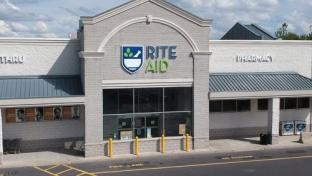How Rite Aid Is Diversifying Business for Long-Term Success
For its first quarter, ending May 28, Rite Aid Corp. has reported that revenues were $6.01 billion, compared with last year's revenues of $6.16 billion, while adjusted EBITDA was $100.1 million, compared with last year's $138.9 million.
Rite Aid CEO Heyward Donigan is concentrating on the future, however. During the company’s Q1 earnings call, she emphasized how the company is refocusing its efforts to become a leading “full-service and modern pharmacy.”
“We're focused on winning in three key areas: deepening our share in the markets and segments we currently serve; expanding our offerings to new markets, segments and customers; and creating new offerings by leveraging our portfolio of assets to meet the evolving needs of customers and other stakeholders,” said Donigan.
As consumer discretionary spending comes under significant pressure, Rite Aid is investing in its own brands. “As we've discussed, we've been on a journey to repackage, rename and relaunch our own-brand portfolio,” noted Donigan. “This quarter, we launched 546 or 23% of our newly designed products, and we have exciting new launches coming in the back half of this year.”
Rite Aid has invested heavily in elevating its beauty assortment to focus on wellness and clean brands. “We continue to enhance our new beauty assortment in the front end and had encouraging results on our new line item launches in our color cosmetics business,” said Donigan. “This resulted in a 5.7% revenue growth in the color cosmetics department this quarter.”
Following the previously revealed closing of more than 140 stores, the company is also on track to open at least five of its new small-format pharmacies this year, which was originally mentioned during last quarter’s earnings call. These small-format pharmacies will be located in underserved rural markets in Indiana, upstate New York and Virginia, and will feature a limited over-the-counter front end.
In line with serving rural markets, Rite Aid recently established a partnership with Homeward, a San Francisco-based company aimed at rearchitecting health care for the millions of Americans living in these communities. “Beginning this summer with a partnership in rural Michigan, we'll be working with Homeward to provide an integrated pharmacy and clinical services offering to our mutual customers,” said Donigan.
The company is also focusing efforts on its revamped Rite Aid Rewards loyalty program, launched Feb. 28. The digital-first program allows the company to be much more personalized in how it communicates with customers.
“And as we mature into the program in the back half of this year, there will be offers that extend beyond products,” said Andre Persaud, EVP, chief retail officer. “That really brings us in line with our overall purpose, which is, of course, [to] help you achieve full health for life.”
More emphasis will be placed on building its digital capabilities as the company advances its buy-online-pickup-in-store program and expands both mail and delivery services options. "These services encompass both prescriptions and retail goods to create a one-stop-shopping experience,” said Donigan. She also mentioned that the company will launch a new direct-to-consumer digital platform later this summer, which will be discussed in company’s next earnings call.
“We continue to make strides on our journey to transform Rite Aid and define the modern pharmacy,” said Donigan. “In the first quarter, we increased our non-COVID prescriptions, reduced SG&A, built momentum at [wholly owned pharmacy services subsidiary] Elixir, and delivered solid results across the business.”
More Q1 Numbers
First-quarter net loss for Rite Aid was $110.2 million, or $2.03 per share, compared with last year’s first-quarter net loss of $13.1 million, or 24 cents per share. Adjusted net loss was $32.8 million, or 60 cents per share, compared with last year’s first-quarter adjusted net income of $20.9 million or 38 cents per share. The increase in adjusted net loss was reportedly due primarily to higher facility exit and impairment charges driven by the company’s previously revealed store closure decisions and a decrease in adjusted EBITDA. These items were partly offset by an increase in gain on sale of assets resulting from script file sales of certain of the store closures.
The retail pharmacy segment adjusted EBITDA was $73.7 million, or 1.7% of revenues, for the first quarter, compared with last year’s $94.9 million, or 2.2% of revenues. The decline in adjusted EBITDA was due to decreased gross profit, partly offset by a decrease in adjusted EBITDA SG&A expenses of $40.5 million. Gross profit was negatively affected by the decline in COVID-19 vaccinations and testing. SG&A expenses benefited from lower payroll, occupancy and other operating costs due to store closures and cost control initiatives.
Same-store sales for the first quarter increased 4.6% over the prior year period. Prescription sales accounted for 70.8% of total drug store sales.
Total store count at the end of the first quarter was 2,361.
Outlook for Fiscal 2023
Going forward, Rite Aid expects to generate positive free cash flow in fiscal 2023, increasing its outlook for revenues. Total revenues are expected to be between $23.6 billion and $24.0 billion. Retail pharmacy segment revenue is expected to be between $17.35 billion and $17.65 billion, and pharmacy services segment revenue is expected to be between $6.25 billion and $6.35 billion.
Adjusted EBITDA is expected to be between $460 million and $500 million. Retail pharmacy segment adjusted EBITDA is expected to be between $320 million and $350 million.
Capital expenditures are expected to be approximately $250 million, with a focus on investments in digital capabilities, technology, prescription file purchases, distribution center automation and store remodels.
“I'm really energized by where Rite Aid is today, and I'm really excited for the future as we get back on track, back to our RxEvolution that we planned before the pandemic hit," said Donigan, "and as we continue to execute on our strategy, I do believe that Rite Aid will be an investment that will yield meaningful, long-term returns for all of our stakeholders.”
With more than 2,300 retail pharmacy locations across 17 states, Camp Hill, Pa.-based Rite Aid is No. 21 on The PG 100, Progressive Grocer’s 2022 list of the top food and consumables retailers in North America.







